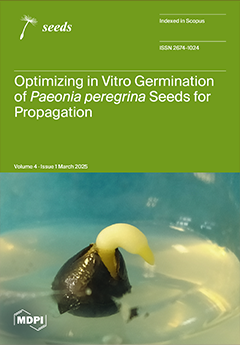Herbaceous peonies, specifically the Balkan–Anatolian
Paeonia peregrina Miller, are species with various uses such as ornamental and garden purposes, or they can be cut as flowers or potted, or they can be eaten or used for medicinal purposes due to the rich nutritional
[...] Read more.
Herbaceous peonies, specifically the Balkan–Anatolian
Paeonia peregrina Miller, are species with various uses such as ornamental and garden purposes, or they can be cut as flowers or potted, or they can be eaten or used for medicinal purposes due to the rich nutritional content of their seeds. However, conventional propagation methods, including rhizome division, grafting, and layering, are slow, while seed propagation is challenging due to double morpho-physiological dormancy. This study therefore evaluated the in vitro germination potential of
P. peregrina seeds in darkness under different culture conditions, including different temperature regimes (constant at 15 °C or alternating from 22 °C to 15 °C); incubation periods [120 days: 22 °C (14 d) to 15 °C (0–105 d); 120 days: 22 °C (33 d) to 15 °C (0–87 d); 90 or 140 days at 15 °C]; seed cold storage period (none; 30 days; 3 months; or 2, 5, and 8 years); and gibberellic acid (GA
3) concentrations (0, 250, 500, 750, and 1000 mg L
−1), as dormancy release methods. The results indicated that 60-day-stored seeds (30 d at 15 °C and 30 d cold-storaged at 4–5 °C) exhibited 100% germination within an 80-day culture under 250 mg L
−1 GA
3 at 15 °C. A lower and constant temperature of 15 °C, a shorter 30-day seed cold storage period, and the lowest GA
3 concentration of 250 mg L
−1 comprised the most effective combination treatment for dormancy release and germination acceleration. An understanding of the underlying mechanisms of seed dormancy removal is imperative for successful germination, growth rate and seedling establishment, shortened breeding cycles, and germplasm conservation, leading to the field cultivation and economic production of these peony plants.
Full article





